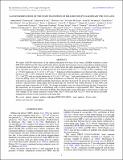NuSTAR OBSERVATIONS OF THE STATE TRANSITION OF MILLISECOND PULSAR BINARY PSR J1023+0038
Author(s)
Chakrabarty, Deepto
DownloadTendulkar-2014-NuSTAR OBSERVATIONS.pdf (1.175Mb)
PUBLISHER_POLICY
Publisher Policy
Article is made available in accordance with the publisher's policy and may be subject to US copyright law. Please refer to the publisher's site for terms of use.
Terms of use
Metadata
Show full item recordAbstract
We report NuSTAR observations of the millisecond pulsar-low-mass X-ray binary (LMXB) transition system PSR J1023+0038 from 2013 June and October, before and after the formation of an accretion disk around the neutron star. Between June 10 and 12, a few days to two weeks before the radio disappearance of the pulsar, the 3-79 keV X-ray spectrum was well fit by a simple power law with a photon index of Γ = 1.17[+0.08 over -0.07] (at 90% confidence) with a 3-79 keV luminosity of 7.4 ± 0.4 × 10[superscript 32] erg s[superscript –1]. Significant orbital modulation was observed with a modulation fraction of 36% ± 10%. During the October 19-21 observation, the spectrum is described by a softer power law (Γ = 1.66[+0.06 over -0.05]) with an average luminosity of 5.8 ± 0.2 × 10[superscript 33] erg s[superscript –1] and a peak luminosity of ≈1.2 × 10[superscript 34] erg s[superscript –1] observed during a flare. No significant orbital modulation was detected. The spectral observations are consistent with previous and current multiwavelength observations and show the hard X-ray power law extending to 79 keV without a spectral break. Sharp-edged, flat-bottomed dips are observed with widths between 30 and 1000 s and ingress and egress timescales of 30-60 s. No change in hardness ratio was observed during the dips. Consecutive dip separations are log-normal in distribution with a typical separation of approximately 400 s. These dips are distinct from dipping activity observed in LMXBs. We compare and contrast these dips to observations of dips and state changes in the similar transition systems PSR J1824–2452I and XSS J1227.0–4859 and discuss possible interpretations based on the transitions in the inner disk.
Date issued
2014-07Department
Massachusetts Institute of Technology. Department of Physics; MIT Kavli Institute for Astrophysics and Space ResearchJournal
The Astrophysical Journal
Publisher
IOP Publishing
Citation
Tendulkar, Shriharsh P., Chengwei Yang, Hongjun An, Victoria M. Kaspi, Anne M. Archibald, Cees Bassa, Eric Bellm, et al. “NuSTAR OBSERVATIONS OF THE STATE TRANSITION OF MILLISECOND PULSAR BINARY PSR J1023+0038.” The Astrophysical Journal 791, no. 2 (July 29, 2014): 77. © 2014 The American Astronomical Society
Version: Final published version
ISSN
1538-4357
0004-637X